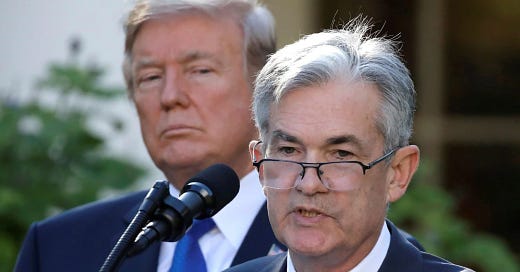Rabo: "Powell may just have made a new enemy" in Trump
The bank continues to Point Out Powell's Contradictions
TABOO
By Bas Van Geffen, Senior Macro Strategist at Rabobank via ZeroHedge
This week we learned how (not) to say you believe you may be behind the curve without saying you are behind the curve, like a bad game of Taboo. Markets continued to celebrate the outsized Fed cut yesterday. Equity markets around the globe posted further gains, with Europe up 1.8% and the S&P 500 climbing 1.7%. But other than that, the decision could still backfire for Powell. Both in terms of credibility, and in terms of politics.
[IN-Credibility]
Starting with his credibility, Powell’s explanation of the 50bp move raised many an eyebrow this week. The Fed Chair refuted that the central bank had fallen behind the curve, saying that it was merely “recalibrating” its policy. Hilarity ensued when Powell then explained the move by stating that the Fed had been so patient, that it was now able to implement a bigger rate cut. Yet, isn’t the sole reason to take bigger steps that you’ve fallen behind and now have to catch up?
Likewise, the 50bp cut did not resonate with the Fed’s assessment that the economy is still “strong”. As our US strategist argued, the whole press conference could have come straight from Orwell’s 1984: “War is peace; Freedom is slavery; Ignorance is strength.” Does the latter also apply to central bankers nowadays?
Finally, considering the latest dot plot, it’s also odd that the FOMC voted 11 to 1 in favor of the outsized cut. The strong backing for a large step contrasts with the individual policymakers’ forecasts of the end-2024 Fed funds rate. The median forecast now corresponds to 100bp of cuts before the end of the year. With only three meetings available (including this week’s), that could only be attained if the Fed cut by 50bp at one of these meetings. Powell clearly chose to frontload this. Yet, this median forecast masks the underlying disagreement: if only one FOMC member were to change their mind, the median forecast would switch from 100bp of easing in 2024 to just 75bp. Given that 50bp have been delivered this week, that would essentially require the Fed to skip November or December!
We weren’t the only ones to notice these inconsistencies in Powell’s reasoning, and that could just cost him his job. Donald Trump took the outsized rate cut to attack both Harris’ economic agenda and the Federal Reserve: “I guess it shows the economy is very bad to cut it by that much, assuming they’re not just playing politics.” The presidential candidate had already suggested that the Fed could cut rates close to the election for political reasons. And Trump has been quite vocal about wanting to shake up the Fed. So, Powell may just have made a new enemy. And as our US strategist noted, Bowman’s dissenting vote may just have put her in a prime position to take over the helm at the central bank if Trump gets voted back into the White House.
Besides, Powell’s reasoning stands to shed a whole new light on the latest rate decisions elsewhere in the world.
[IN Context]
First, the Bank of England held rates unchanged at 5.00% yesterday, as we had expected. Only one dove dissented from the decision in favour of a rate cut, making this a slightly more hawkish hold than the 7-2 split that the market had been expecting. Our UK strategist believes that Deputy Governor Ramsden may have successfully made the case to keep a gradual pace during this easing cycle. The monetary policy committee believes there is a premium on patience. The first ‘sweet spot’ for rate cuts has passed, and remaining risks of an inflation rebound warrant such caution. Either that, or the Bank of England is following the Fed’s “recalibration” strategy of “patiently building momentum” to cut big at a future meeting...
Secondly, considering the Fed’s new logic that 50bp means the economy is doing great, the Japanese economy must be in awful shape for the Bank of Japan to leave policy rates unchanged this morning.
All joking aside, the Bank’s decision to hold had been widely expected. Markets were mainly looking for Governor Ueda’s guidance about potential future hikes. Ueda noted that the economy is coming in line with policymakers’ views, and the central bank will adjust the degree of policy accommodation if the outlook is realised. However, policymakers appear to be in less of a rush now that upside inflation risks have eased. The central bank still expects that wages will continue to rise, but the price risks from JPY depreciation have faded according to the policymakers. So, in short, the Bank of Japan can afford some patience.
And policymakers may use that patience: Ueda noted that financial markets are still unstable, and so the Bank will try to time their next rate hike well. At least Ueda acknowledged the events in July. The governor said he’s aware of the criticism of the Bank of Japan’s communication ahead of the rate hike. Will Powell issue a similar mea culpa for the Fed’s communication ahead of the jumbo cut and his bodged explanation of the decision?




